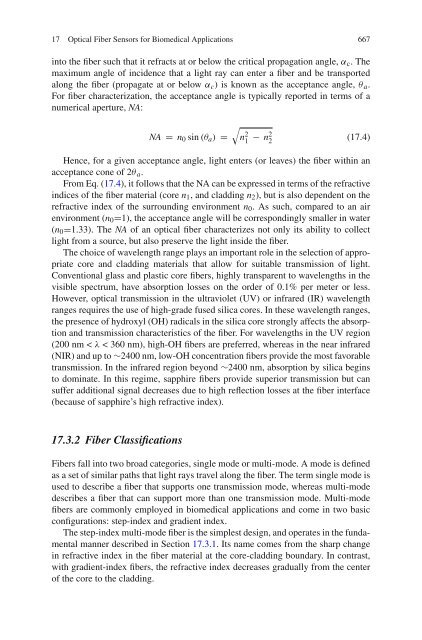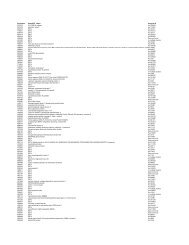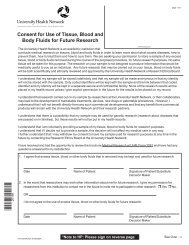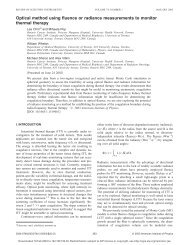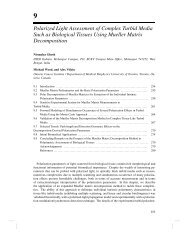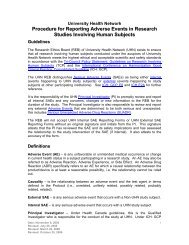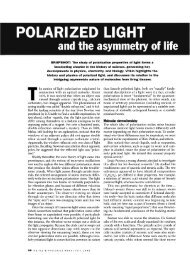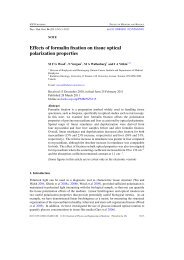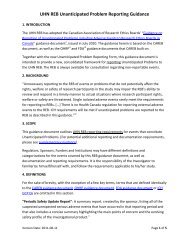Optical Fiber Sensors for Biomedical Applications
Optical Fiber Sensors for Biomedical Applications
Optical Fiber Sensors for Biomedical Applications
You also want an ePaper? Increase the reach of your titles
YUMPU automatically turns print PDFs into web optimized ePapers that Google loves.
17 <strong>Optical</strong> <strong>Fiber</strong> <strong>Sensors</strong> <strong>for</strong> <strong>Biomedical</strong> <strong>Applications</strong> 667into the fiber such that it refracts at or below the critical propagation angle, α c .Themaximum angle of incidence that a light ray can enter a fiber and be transportedalong the fiber (propagate at or below α c ) is known as the acceptance angle, θ a .For fiber characterization, the acceptance angle is typically reported in terms of anumerical aperture, NA:NA = n 0 sin (θ a ) =√n 2 1 − n2 2(17.4)Hence, <strong>for</strong> a given acceptance angle, light enters (or leaves) the fiber within anacceptance cone of 2θ a .From Eq. (17.4), it follows that the NA can be expressed in terms of the refractiveindices of the fiber material (core n 1 , and cladding n 2 ), but is also dependent on therefractive index of the surrounding environment n 0 . As such, compared to an airenvironment (n 0 =1), the acceptance angle will be correspondingly smaller in water(n 0 =1.33). The NA of an optical fiber characterizes not only its ability to collectlight from a source, but also preserve the light inside the fiber.The choice of wavelength range plays an important role in the selection of appropriatecore and cladding materials that allow <strong>for</strong> suitable transmission of light.Conventional glass and plastic core fibers, highly transparent to wavelengths in thevisible spectrum, have absorption losses on the order of 0.1% per meter or less.However, optical transmission in the ultraviolet (UV) or infrared (IR) wavelengthranges requires the use of high-grade fused silica cores. In these wavelength ranges,the presence of hydroxyl (OH) radicals in the silica core strongly affects the absorptionand transmission characteristics of the fiber. For wavelengths in the UV region(200 nm < λ < 360 nm), high-OH fibers are preferred, whereas in the near infrared(NIR) and up to ∼2400 nm, low-OH concentration fibers provide the most favorabletransmission. In the infrared region beyond ∼2400 nm, absorption by silica beginsto dominate. In this regime, sapphire fibers provide superior transmission but cansuffer additional signal decreases due to high reflection losses at the fiber interface(because of sapphire’s high refractive index).17.3.2 <strong>Fiber</strong> Classifications<strong>Fiber</strong>s fall into two broad categories, single mode or multi-mode. A mode is definedas a set of similar paths that light rays travel along the fiber. The term single mode isused to describe a fiber that supports one transmission mode, whereas multi-modedescribes a fiber that can support more than one transmission mode. Multi-modefibers are commonly employed in biomedical applications and come in two basicconfigurations: step-index and gradient index.The step-index multi-mode fiber is the simplest design, and operates in the fundamentalmanner described in Section 17.3.1. Its name comes from the sharp changein refractive index in the fiber material at the core-cladding boundary. In contrast,with gradient-index fibers, the refractive index decreases gradually from the centerof the core to the cladding.


